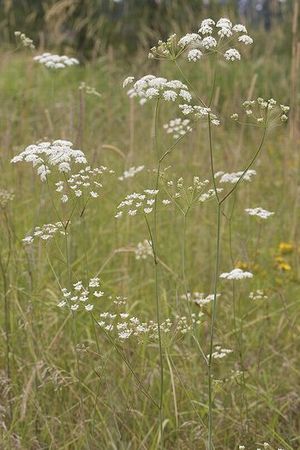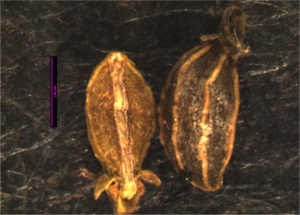Perideridia montana
Perideridia gairdneri, also called Gairdner's yampah, common yampah, or Gardner's yampah is a flowering plant in the carrot family (Apiaceae).
Contents
Taxonomy
- Kingdom - Plantae
- Subkingdom - Tracheobionta
- Superdivision - Spermatophyta
- Division - Magnoliophyta
- Class -Magnoliopsida
- Subclass - Rosidae
- Order - Apiales
- Family - Apiaceae
- Genus - Perideridia
- Species - P. gairdneri
Description
General: Slender, glabrous perennial from a tuberous-thickened, edible, usually solitary root, the solitary stem 4-12 dm. tall. Leaves: Leaves several, well distributed along the stem, the blade once pinnate or ternate; the ultimate segments elongate and narrow. Flowers: Inflorescence of terminal and 1-several lateral compound umbels, the umbels 2.5-7 cm. wide; rays up to 6 cm. long at maturity; involucre of a few, narrow bracts; involucre of bristly bracelets, or wanting; calyx teeth well developed; flowers white. Fruit: Fruit glabrous, sub-orbicular, 2-3 mm. long and wide, with prominent ribs.
-cnlm pages
Bloom Period
July to August
Distribution
Occurs from southern B.C. to southern California and east to Saskatchewan, South Dakota and Colorado -cnlm pages
Habitat
Perideridia gairdneri prefers well-drained, nitrogen medium soils. It tolerates slightly acid to mildly alkaline soils. It is very shade intolerant. It is a climax species in drier sites, and is found in the meadow communities in Garry oak ecosystems. Grows from low to middle elevations.
CNLM pages
Uses
Roots either eaten boiled or dried and pounded to make a flour with an anise seed-like taste
Blackfoot Drug (Antidiarrheal) - Infusion of roots taken to counteract cathartic and emetic effects of another infusion.
Blackfoot Drug (Antiemetic) - Infusion of roots taken to counteract cathartic and emetic effects of another infusion.
Blackfoot Drug (Breast Treatment) - Infusion of roots used to massage sore breasts with warm stones
Blackfoot Drug (Cough Medicine) - Infusion of roots or roots chewed for coughs.
Blackfoot Drug (Cough Medicine) - Root smudge smoke inhaled for nagging coughs.
Blackfoot Drug (Dermatological Aid) - Infusion of roots applied to sores and wounds.
cnlm pages
Propagation
Hand collect seeds in August when seeds have turned brown and are easily stripped off inflorescence into paper bags. Store seeds in sealed containers at 5º C. Seed will retain viability for up to five years. Sow seeds in fall and allow natural stratification, or sow stored seeds in the spring after six to eight weeks of cold, moist stratification.
The Seed
Peridendia gairdneri
PEGA
Seed sample from 2011
Features
Average Measurement: 2.3 x 1 x 1
Measurement Range: L: 1.5 – 3, W: 0.8 – 1.1, D: 0.75 – 1.3
Latitudinal Cross Section: ovate
Longitudinal Cross Section: elliptical
Shape: Seed schizoid, flat on one plane, and rounded on the opposite plane. Lots of irregularity in shape.
Color: Various shades of green and brown. Hilum usually white. Some seeds have pink from remnant flower structure at apex opposite hilum.
Surface: Seeds have five ridges on outer seed face that run from hilum to opposite apex longitudinally. Inner seed face has one white rib that bisects the seed face.
Basic Explanations and Assumptions:
The dimensions for the seeds are length x width x depth. The location of the hilum is used as the base of the seed, and the length is measured from hilum to the opposite apex. Where a style is present, the length is measured from the hilum to the bottom of the style. Width is measured at a right angle to the length at the widest part. Depth is measured at a right angle to the intersection of height and width lines.
Measurements included are the mean average for each measurement of ten separate seeds.
All measurements in millimeters unless otherwise noted.
Photo Gallery
References
- ↑ USDA, NRCS. 2012. The PLANTS Database (http://plants.usda.gov, 16 April 2012). National Plant Data Team, Greensboro, NC 27401-4901 USA.
- ↑ Source: http://biology.burke.washington.edu/herbarium/imagecollection.php
- ↑ Pojar, MacKinnon 1994



